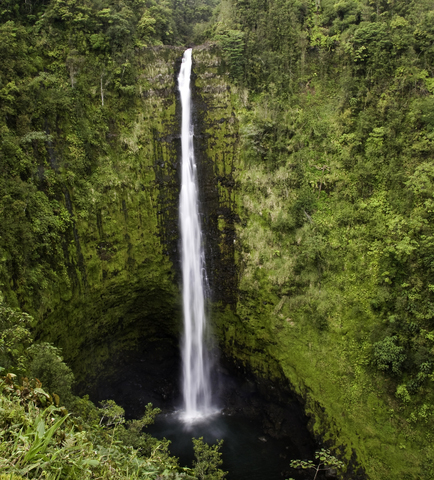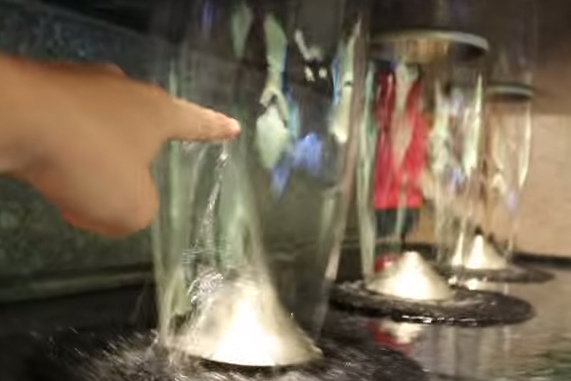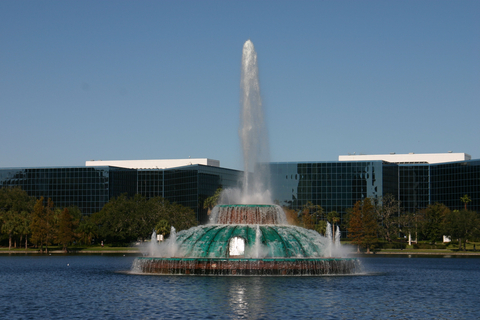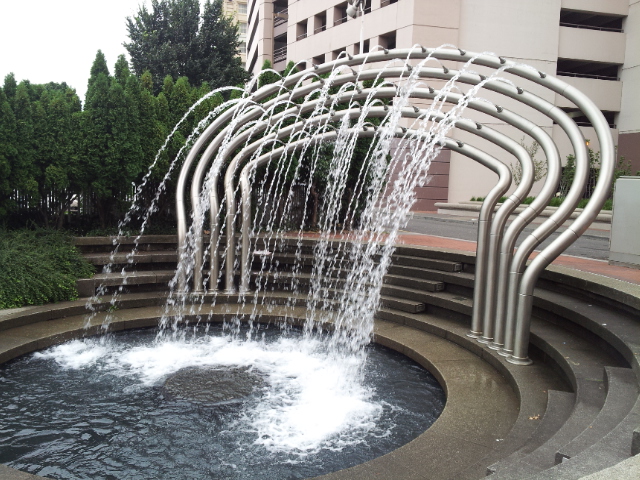Travelogues & History
Just recently, a business acquaintance suggested I would enjoy a meeting scheduled for a downtown Los Angeles hotel. I figured I'd go because the Museum of Contemporary Art is right down the street and I hadn't been there for a while. So off I went, braving rush-hour traffic, biting hard when I discovered it would cost me nearly $40 to park for the morning and doing my best to
Over the holidays this past December, we broke with family tradition and, instead of gathering around tree and hearth as we've done as a family every year since 1982, all of us headed to the Big Island of Hawaii for an entirely new sort of celebration. My wife and I had been there once before, staying at what was then the newly opened Hyatt Regency Waikoloa for a meeting of the National Spa & Pool Institute's Board of Directors. (I recall that Skip Philips was chairman at the time.) After that meeting nearly 25 years ago, Judy and I had taken several extra days and motored around the island at a leisurely pace, staying in tiny motels and spending most of our time
When I prepare my Travelogues, I always spend some time, usually midway through the process, looking at what's available on the Internet to support the basic observations I'm getting ready to offer. Often, for example, I'll confirm information I already have about designers or engineers or installers (and their clients), touching all the bases to get the details right. As important, I'm on the lookout for
I haven't called attention to many of what you might call "conventional" fountains in my Travelogues. You know what I mean: the standard sort of bowl fountains with modest flows, bronze sculptures and lots of patina. It's not that I haven't come across many that I like and admire during my travels; it's just that most of their stories seem a bit too similar.
In the case I'll discuss here, however, there's an odd tale of déjà vu to tell: Back in July of 1978, while I was in Rome, I sought out fountains just about wherever I walked around the city because it was so unbelievably hot. Even small fountains were islands of coolness under the intense Italian sun.
One of the fountains I encountered looked familiar when I crossed its path: The Fontana delle Tartarughe (seen above) wasn't s show-stopper by any means, but it was charming and cooling - and challenged me with the nagging sense that I'd seen it before.
Set where there had once been a fountainhead for the Roman aqueduct system, this one had been built in the 1580s as the collaboration of an architect, Giacomo della Porta, and a sculptor, Taddeo Landini. The creatures that lent the fountain its name were added about 80 years later during a restoration project; they were by either Gian Lorenzo Bernini (which would be exciting, as he was a truly great artist and architect) or by Andrea Sacchi, a renowned painter (but not anywhere close to Bernini's league).
My guidebook, long gone, doubtless told me all of this, and I'm certain the Bernini connection would've caught my eye. But what really grabbed me was the translation of tartarughe it offered: This was the "Fountain of the Tortoises" - and I had indeed seen it before, only the last time it had been in a small park on Nob Hill in San Francisco.
About four years before my visit to Rome, I'd spent a week in San Francisco, walking up and down hills and exploring everything I could reach on my happy 18-year-old feet. I'd been to Nob Hill and had walked through Huntington Park and had seen what turned out to be a reproduction (seen just above) of the Fontana delle Tartarughe that had graced the space since 1954.
It was all about the tortoises, both times. They looked a bit silly hanging out over the edge of the large fountain bowl, so when I saw them again in the same absurd posture in Rome years later, it triggered the memories and kicked up a curiosity that made me linger long enough that I checked my guidebook and saw that tartarughe translated to tortoise - and I knew in a flash where I'd see this before.
You can go to Rome to see the original, but to me the San Francisco version has almost as much going for it - other that 450 years of art history atop 2,000 years of Roman hydrological history, of course. Cool in either place, I'd say.
Way back in my Pool Spa News editor days - I want to say circa 1990, but I may be off by a year or two - we ran a piece on a waterfeature built by Mike Stachel of Mt. Lake Pool & Patio (Doylestown. Pa.) to meet the needs of the Philadelphia Zoo's relentlessly cute capybaras.
I've forgotten all of the details of the article (which, as a small twist of fate would have it, was written by future WaterShapes editor Eric Herman) other than the relentless cuteness of the creatures for whom the watershape was built, but enough of the memory of the project lingered that I made a point of stopping by the zoo while visiting the city ten or twelve years later to see how the critters were getting on. I also wanted to see whether they were as darned cute in person as they had been in Mike's photographs.
I wasn't prepared in any way for the fact that they were actually too large to be considered cute. They were taller and longer and more girthsome than the photos I'd seen had led me to believe. I couldn't help thinking of them as supersized squirrels with bigger, sharper teeth and voracious appetites to match. The horror . . .
Fortunately, there was much else to see at the zoo. Before I was anywhere near the capybara enclosure, in fact, I strolled up to and past the Impala Fountain and knew I'd come back for a longer look once I'd paid my respects to my rodent friends and Mike Stachel's handiwork.
The Impala Fountain belongs to a class of waterfeatures for which I have something of a weakness - that is, fountains that feature wild animals interacting with water. I love the horses running up the steps at the entrance of Denver's Mile-High Stadium, for example, and I'm truly smitten by the mustangs that race across the stream in williams square irving,
The difference in this case is that the impalas (executed between 1950 and 1963 by Philadelphia sculptor Henry Mitchell, are distinctly abstract - basically skeletonized versions of a dozen of these great and amazing leapers set in an arc above fountain jets, doubtless in flight from one sort of predator or another.
To me, this is an ideal combination of sculpture and water where the kinetic nature of the fountain jets lends a direct sense of movement to the static sculptural elements. It's simply drop-dead gorgeous - and well worth a visit the next time you visit the Philadelphia Zoo to see Mike Stachel's fearsome capybaras.
I love the fact that she was a friend and compatriot to Jackson Pollock, Willem de Kooning, Mark Rothko and other leading lights among the abstract expressionists. I love that she lived to be 98 and, just before her death in 2010, was still engaged enough by the world around her to start communicating through her art in support of the lesbian, gay, bisexual and transgender community. I love her name, which would have been the perfect alias for an avant-garde artist of the 20th Century but for the fact that it's really hers. Finally, I love her big sculptures, including the 25-foot-tall one in Agnes R. Katz Park in Pittsburgh, Pa.
Maybe the only thing about Louise Bourgeois' work I think I don't like is that she decided that the 25-foot-tall one in Katz Park would make a good fountain. I just have to disagree with her decision and don't find myself being satisfied or happy in its presence.
The park took shape in 1998 and was dedicated to the memory of Ms. Katz, a prominent patron of the arts. The fountain sculpture dominates the space, which was designed by the renowned architect Michael Graves in collaboration with Daniel Urban Kiley, a distinguished landscape architect, as well as Ms. Bourgeois, who also contributed three paired benches (seen partly in the photo above by Daderot | Wikipedia) that, because of their shapes, have lent the space its nickname: "Eyeball Park."
I savor the oddly disturbing eyeball benches and admire the towering nearby structure as a sculpture, but as I mentioned above, I have my problems with it as a fountain. Yes, I get the symbolism of the two flows at the top joining into a single flow down the structure and its supposed reference to the Allegheny and Monongahela coming together in Pittsburgh to form the Ohio River. But the water element nonetheless seems forced: The sculpture existed before its placement was a consideration; Ms. Bourgeois was a committed New Yorker rather than a Pittsburgher; and I can't help thinking that the plumbing might have been an afterthought?
Mainly, I'm bothered by the timid way the water flows down through the sculpture's levels: It starts out nicely enough at the top but flows unenergetically downward, sometimes narrowing, sometimes expanding as it drops, leaving the structure mostly dry. I tried to convince myself that this worked; ultimately, however, I just couldn't buy it.
Even though it doesn't transport me, however, I do appreciate the fact that the tower runs with heated water and flows a considerate 365 days a year. It was springtime when I saw it, but I wish I'd seen it draped in icicles in the dead of winter (as seen in some photos linked below). I've always been a sucker for the concept of frozen waterfalls, streams and fountains, so, for part of the year at least, this fountain might just win me over.
For all my criticism, I still think it's a great little park in the heart of the city's thriving cultural district - well worth a visit. And frankly, I'd be delighted to hear from anyone who can offer a persuasive defense of the project, because it's pretty clear to me that I'm looking for reasons to appreciate this composition as much as I like so much of Louise Bourgeois' other work!
To see a video of the fountain in operation, click here.
To see the fountain partly covered in ice, click here.
Please don't hold it against me: I was an English Literature major in college.
My specialty was the old stuff - Shakespeare's plays, the comedies of the Restoration period, poets from John Milton to Alexander Pope, and the early novelists, especially Jane Austen. It was mostly a pursuit of things written before about 1820 and kept me more than busy.
About eight months after I graduated in 1977, I took off and traveled the world for the best part of a year, spending May and June of 1978 in England and devotedly seeking out places where my favorite subjects of study had lived and worked and found inspiration. I went to the places where the great theaters had been and tramped along rivers and city streets listening for echoes and seeing if there was anything left that would attach me to the life experiences of my literary heroes.
It was all fairly thin until I reached the city of Bath, where Jane Austen had centered so many scenes in her great novels. Back in 1978, the place hadn't changed all that much since she'd lived there; it still embodied a mood and architectural style that easily carried me back 200 years to her time.
For all of her virtues, however, Miss Austen wasn't hugely impressed by Bath or at all into the one feature of the city that most thoroughly captured my imagination while I was there - that is, the natural watershapes that gave the town its name and had defined its function at least since the Romans reached England nearly 2,000 years earlier.
I'm mindful of the fact that I took this trip well before watershaping came to define my own function and life. Even then, however, I was blown away by the thought that the Romans had settled in this place around 70 A.D. and had converted the site's warm springs into a system of pools to serve as an early spa.
Not much is visible from those times; in fact, the baths were basically forgotten and buried after the Romans left a couple centuries later and were only rediscovered in Shakespeare's time. But seeing the still-visible parts of the Roman baths in person - and absorbing all I could about their inner workings from a memorable museum exhibit - I felt as though I was witnessing history in the grandest and most personal way possible.
When you take that history and surround it with graceful Georgian architecture, the package Bath offers its visitors is quite complete and unique. And so tasteful, I might add, that I have to think that even a Roman would have been pleased to see their baths set amid such a splendid and sociably neoclassical context.
No, you can't "take the waters" the way they did when Jane Austen was around, but it's well worth a visit: For inspiration, the baths of Bath can't be beat.
The first time I saw it, the water of the Linton E. Allen Memorial Fountain had been turned off for servicing. In that inert condition and with tiny figures creeping over its greenish surface, it looked to me as though a squat flying saucer had dropped in to slurp up water from Lake
One of the nicest days I've ever spent as publisher of WaterShapes came when I joined editor Eric Herman and our good friend William Rowley on the beach in Santa Monica, Calif., one spring day in 2006. Bill was working there on the resuscitation of the swimming pool at the old Marion Davies estate. In the 1920s, she had been William Randolph Hearst's paramour. When she wanted a house built on
In my various trips near and far, I ve occasionally experienced fountains that function only sporadically. if you'll recall, for example, i wrote in december 2012 about ricardo legorreta's purple aqueduct los angeles'pershing square, which, i've been told, runs when the local water table permits it which is why had to visit square three times before witnessed operation.
I've also seen fountains that were installed with either official names or no names at all - but that are universally referred to by locals with other, generally less-respectful names. I wrote in June 2013 about the Inverted Fountain on the UCLA campus, for instance, mentioning that irreverent students (at least of my generation) called it the Perpetual Toilet because of the familiar way the water circled so voluminously into its drain.
Now I offer up a fountain that scores big in both of these odd categories: It's an unnamed fountain in Portland, Ore., that has what is often complained of as an overly sensitive wind sensor that shuts the water off completely at what seems the slightest provocation. It also has the distinction of looking a bit like the sprayer bar in a commercial convenience, so most people call it the Car Wash Fountain.
Made up of rows of curving metal tubes, the fountain was installed in its compact Portland park in 1977 with a design from the firm of Carter, Hull, Nishita, McCulley and Baxter. (Nishita had been an associate of Lawrence Halprin's, but separation from the great man evidently led him on a different stylistic path.) The spray jets apparently make pedestrians miserable when the wind blows (which it often does in Portland), so when the breeze reaches a scant two miles an hour, the water stops flowing. This low threshold makes it a bit too easy to find the Car Wash closed for business.
I have to say that I'm not terribly fond of this fountain - and it's only partially the result of having had the misfortune of stopping by to see it on a cold, blustery day. Basically, I don't think it's an attractive contribution to the cityscape; I'd also like to think it was incumbent on the designers to recognize the problems even a gentle breeze in this particular location would cause with their fountain's basic operation.
That doesn't mean the fountain isn't worth a visit: People who write about Portland's attractions look at it with obvious pride - and it's not just because they like referring to it as the Car Wash Fountain. Maybe it's just me?
Then as now, I look on the bright side: The Car Wash Fountain is within easy walking distance of a bunch of other fine Portland fountains, and it's hard to stay upset when you have about a mile to walk to the Keller and Lovejoy fountains - two of Halprin's masterpieces.
For a very brief video showing the fountain in action, click here.






















